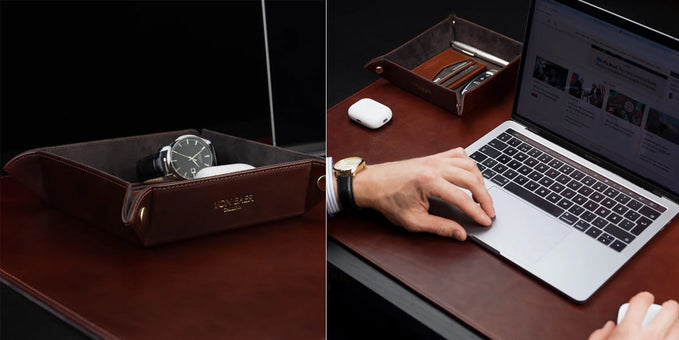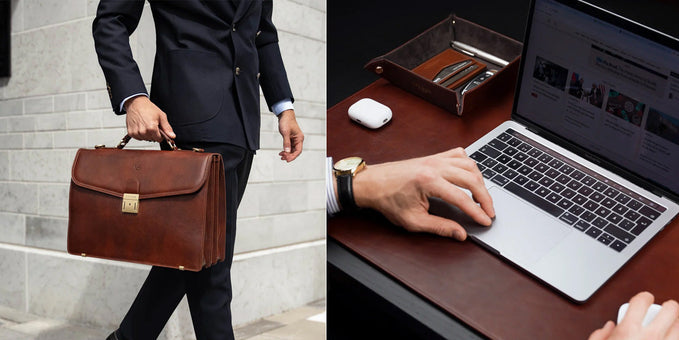How To Stiffen Leather To Make It Harden (DIY Methods)

A good way to increase durability is to harden your leather.
Here are a couple of tips for those who want to either make armor or simply add some extra strength to their leather.
Care should be taken to avoid over-hardening as this will make the leather easily breakable.
Tips Before You Start
- Use veg-tanned leather for the best leather hardening results.
- As chemicals are involved in other tanned leathers, they can be burnt off causing nasty fumes.
- A thick piece of veg-tanned leather should be used for the best results.
Method 1: Boiling water

- Fill a bowl with room temperature water to cover the entire leather piece.
- Let the leather soak in the water for a couple of minutes to absorb enough water for flexibility.
- Prepare a pot of water on a warm burner and bring it to a boil or 180 degrees.
- Remove the pot from the heat and transfer the leather from the bowl into the pot.
- Observe the edges of the leather for curling and darkening within the first 5-10 seconds to ensure the water is hot enough.
- Allow the leather to sit in the hot water for approximately 15-60 seconds, noticing shrinking in size and more curling and darkening of color.
- After the allotted time, remove the leather from the water and stretch it out slightly.
- Note any abnormalities, such as the formation of a pocket, which may be due to over-soaking or excessive heat.
- Consider letting it sit for an additional 5-10 seconds to allow the bubble to disappear and for the leather to swell evenly.
- Once removed from the water, mold and shape the leather as desired.
- Use a plastic wrap to protect the item you're molding the leather onto and place it on a hard or wooden surface.
- Nail or staple the leather down while shaping it around the item to prevent movement and facilitate hardening and shaping.
- Allow the leather to dry completely, which may take around 6-8 hours depending on the initial moisture level.
- Once dry, you will have a durable and shaped piece of leather.
- Note that the leather will swell during this process, making it thicker than its initial state. A harder piece can be achieved by condensing a smaller area of the grain.
Method 2: Hammer Time

- Begin by placing the leather in a bowl of water at room temperature and allowing it to sit for ten minutes before removing it.
- Place the leather in an area where it can be hammered without damaging it.
- Hammer the surface for a few minutes, ensuring the whole area is covered multiple times.
- Note: The leather will take the shape of the head of the hammer as you go. Although this can be unappealing, it can be removed once finished by using your fingers or a roller to smooth it out. Some people choose to leave it for the textured appearance.
- Doing this with a stamped, carved, painted, dyed, or burnt piece of leather will alter the results to a large extent.
- The leather will be much drier than before, which is desirable due to having the water hammered out of it.
- Your leather can now be molded around your item and let sit for a few hours. This method reduces drying time as you will be removing water with hammering.
- Unlike the first method, the leather is thinned out by hammering, which permits the grain to be squashed together to a greater extent, thinning the thick piece and making it more durable.
You can purchase high-value leather working tools, including the hammer here.
Method 3: Leather Baking

- Begin with a bowl of water at room temperature.
- Let the water sit for a couple of minutes.
- Set the oven to 120 degrees Fahrenheit or around 49 degrees celsius (or the lowest possible temperature if it doesn't go that low).
- If the oven doesn't go as low as 120 degrees, set it to the lowest temperature available (e.g., 150 degrees Fahrenheit).
- After ten minutes, remove the leather from the water.
- Start hand molding the leather.
- Continuously run your fingers along the edges and creases as you shape the item.
- Continue molding for a few minutes to facilitate the leather to take shape and hold its form.
- Once the leather holds its shape, place it in the oven.
- The hardening process takes between 30-90 minutes, depending on the desired strength.
- Longer time in the oven makes it harder, but be cautious of making it too brittle.
- After approximately 30-40 minutes, the leather should be fully dried.
- Leave it in the oven for a total of 70 minutes for best results.
- The leather will shrink slightly, making the grain tighter.
- Remove the leather from the oven and allow it to cool for about 10 minutes.
- After cooling, the leather is ready to be worked on immediately.
- Optionally, for a firmer texture with a little moisture, place the leather in an oven at about 200 degrees Fahrenheit for 20 minutes.
- When dry, the leather will become as hard as rock.
Method 4: Hot Wax
- Potential danger of boiling wax: boiling wax can splash and burn anyone nearby, so caution is advised.
- Warning: This method is potentially dangerous.
- I did not try it and do not recommend it.
- Two ways to use wax:
- Prepare the leather item: Stitch, ink, or carve the leather item before proceeding.
- Method 1: Dunking into hot wax:
- Heat a pot of beeswax (or any wax) to approximately 250 degrees Celsius or degrees Farhenheit.
- Submerge the leather item in the hot wax for about 3 minutes.
- Remove the leather item and allow it to cool slightly.
- Shape the item as desired.
- Place the shaped item in an oven heated to 180 degrees Celsius for 10 minutes.
- Method 2: Painting wax onto the leather:
- Melt wax in a pot.
- Wet form the leather.
- Apply coats of melted wax onto the leather.
- The wax provides durability and protects the leather.
- As the wax dries, it becomes more solid.
- For a quicker process, the leather can be cooked for half an hour until it is dry before applying the wax.
Other Techniques
Regular Wet Molding
- Usually, wet molding hardens the leather surface area.
- As it soaks up water, a tighter leather is created.
- This adds durability to an average leather piece but doesn’t last as long as some hardening methods.
- Water added to flat surface areas of leather will help to strengthen it.
- This is useful for bags as it adds extra support or padding.
- Simply soak the leather and allow a few hours for drying.
Compression Molding
- Prepare the leather and gather the necessary materials and equipment.
- Set up the compression molding station with specialized machinery or hydraulic presses.
- Place the leather between two metal plates or molds, ensuring it is properly positioned.
- Apply even pressure to the leather by activating the machinery or hydraulic press.
- Allow the pressure to compress and harden the leather, forming a compacted shape.
- Monitor the process to ensure the pressure is distributed evenly across the leather surface.
- If precise shaping is required, employ compression molding techniques.
- Use compression molding for complex or large leather pieces, such as armor components and structural parts.
- Continuously assess the progress to achieve the desired hardness and compactness.
- Once the desired outcome is achieved, release the pressure and remove the leather from the molds or plates.
- Inspect the compressed and hardened leather for quality and consistency.
Resin Coating
- Prepare and clean the leather surface properly before applying the resin.
- Choose epoxy or polyurethane resin for added strength, rigidity, and protection against wear and tear.
- Follow the manufacturer's instructions for careful application of the resin.
- Apply a layer of resin to the surface of the leather.
- Allow the resin to cure, forming a durable coating.
- The cured resin reinforces the leather, enhancing its resistance to abrasion, stretching, and moisture.
Related articles:
- Repair cat scratches on leather
- Remove water stains from leather
- Clean leather wallet & remove stains/smells
- Remove ink from leather
- Get smell out of leather
- Remove stains from leather shoes
- Clean suede leather bag
- How to reform a leather bag
- How to maintain leather bags
- Repair cracked leather
Interested in a leather bag? Check out the range at Von Baer, including the leather weekender below:
Weekender Men's Leather Weekend Bag
Best for stylish weekend getaways with ample space for clothes and essentials - the perfect companion for any adventure.
Weekender Product Highlights:
| Product | Weekender |
| Material | Full Grain Leather - Certified Vegetable Tanned |
| Laptop Size | up to 16 inch |
| Lining | Durable Cotton Canvas |
| Zippers | YKK Zippers - Italian-Made |
| Handmade? | Handmade in Florence, Italy |
| Straps | Detachable and Adjustable Shoulder Strap |
| Carry-on Compliant? | Yes |
| Width | 55 cm (22 in) |
| Height | 30 cm (12 in) |
| Depth | 23.5 cm (9 in) |
| Weight | 1.9 kg (0.9 lbs) |
| Personalization? | Custom Laser Engraving |
Watch the Weekender product video below:
Successful Hardening Tips
Select the Correct Type of Leather
There are various different types of leather that can be hardened but vegetable-tanned is usually recommended for its capacity to hold shape well.
The leather is put through a natural plant-based material tanning process, resulting in a firmer texture than other tanning methods.
Its excellent molding properties, make it a good choice for boiling water, baking, or hammering hardening techniques.
Test on a Small Piece
An inconspicuous, small piece of leather should be tested before applying any method of hardening to a project.
This permits observation of the effects which can be adjusted if necessary to specific leather types. It also ensures the desired level of hardness is achieved and prevents the risk of damage to the entire project.
A sample swatch of leather should be kept for this testing and for reference purposes.
Related pages:
- Wet leather
- How to clean leather bag
- How to restore faded leather bag
- How to stretch leather
- How to shrink leather
- How to soften leather
- How to wash leather
- How to fix faux leather peeling
- Bonded Leather Peeling
Safety Precautions
When using Hot Water or Wax
Safety must be paramount when using hot water or wax to avoid accidents and burns.
Follow these precautions:
- Use protective gloves: Always wear heat-resistant gloves when working with hot water or wax.
- Ventilation: Make sure the area is adequately ventilated to prevent inhalation of fumes or vapors.
- Avoid skin contact: Ensure skin is covered to prevent burns.
- Use appropriate equipment: Wax melting pots, and heat-resistant containers such as pots made of stainless steel should be used to handle hot water or wax.
When using Chemicals or Resins
If you opt to use chemicals and resins for leather hardening, it’s essential to comply with the instructions of the manufacturer and follow safety precautions.
The following guidance should be considered:
- Follow instructions: Carefully read the instructions provided by the manufacturer of the chemical or resin product and make sure you understand them before using them.
- Ensure a well-ventilated area: Make sure there is sufficient airflow to minimize exposure to fumes or vapors.
- Use protective equipment: Wear gloves, goggles, and a mask for protection against possible splashes, fumes, and inhalation.
- Dispose of waste properly: Follow local safe disposal regulations and guidance for any chemicals or residues.
Aftercare and Maintenance
Specific care and maintenance may be necessary for the preservation of appearance and durability.
The following tips should be considered:
- Clean regularly: Clean hardened leather with a soft, damp cloth for dirt and debris removal. Do not use harsh chemicals or abrasive cleaners as they may cause surface damage.
- Conditioning: Condition with a leather conditioner or a specialized product recommended by the manufacturer periodically. This will help maintain suppleness and prevents brittleness or drying out.
- Temperature and moisture protection: Do not expose hardened leather to high moisture levels or extreme temperatures, store items in a cool, dry place away from direct sunlight.
- Excessive bending or folding: Although hardened leather is more durable, it remains important to avoid excessive bending or folding, as this may cause the leather to weaken in time. Hardened leather items should be handled with care and not subjected to unnecessary strain.
Related pages:
- Bleach On Leather
- How To Fix Scuffed Leather
- Leather
- Leather guide for beginners
- Where does leather come from
- Leather grades
- How is leather made
- How to tell if leather is real
Alternative Uses of Hardened Leather
Hardened leather has been used in various applications throughout history and in contemporary contexts, apart from traditional armor-making.
Exploration of these alternatives should be considered along with their unique benefits:
- Shoe soles: Durable and supportive shoe soles can be made from hardened leather which provides a long-lasting synthetic material alternative.
- Book covers: Leather book covers or journals can be hardened to give a distinctive appeal to their aesthetics and also for protection. Leather hardness helps to preserve the contents and, in turn, prolongs the life of the book.
- Accessories: Shaped and molded hardened leather made into various accessories such as belts, wallets, and jewelry, offer a rugged appearance in addition to durability.
- Structural elements: Hardened leather has been used in architectural and design applications for the creation of decorative or structural elements, including wall panels or furniture accents, it adds a uniqueness to interior spaces.
Historical and Cultural Significance
The cultural and historical significance of the use of hardened leather in different civilizations and time periods provides a broad perspective on its use and evolution.
Consider the following points:
- Historical armor-making: Throughout history, hardened leather has been crucial in armor-making. Ancient civilizations including Romans and medieval knights have used hardened leather to provide affordable and accessible forms of protection.
- Indigenous leatherworking traditions: Around the world, indigenous cultures have developed unique techniques to harden and shape their leather which they passed down through generations. These techniques reflect the ingenuity of these communities and their cultural heritage.
- Contemporary artisanal practices: Artisans and craftsmen continue to explore and experiment with leather hardening methods in modern times Traditional techniques are combined with contemporary design aesthetics. The enduring appeal and versatility of hardened leather as a material are demonstrated by this fusion of old and new.
- Symbolism and storytelling: In the context of armor especially, hardened leather carries symbolic significance in heroism tales, battles, and folklore. An exploration of these tales offers a deep understanding of the historical and cultural context in which hardened leather was used.
FAQs
How to harden leather without breaking it?
Successful leather hardening is achieved without leaving crack marks on the material by employing proper techniques moderately. Soaking in a bowl of water at room temperature for approx. ten minutes are the basics.
This will slightly stiffen the leather and works well on vegetable-tanned leather. If a more effective result is desired, the piece of leather should be further soaked in boiling water (180 degrees Fahrenheit) or baked at 120 degrees Fahrenheit in an oven for ten to thirty minutes. Alternatively, wax with melted Beeswax.
How to stiffen a leather couch?
For sagging couches, apply a suitable leather hardener. some leather enthusiasts have discovered how to harden leather with glue. Follow the steps involved to make leather cushions look great again.
Can you stiffen leather with water?
A liquid leather stiffener is recommended by most people for hardening leather; however, it is possible to learn how to use water to achieve tremendous results. The items necessary are water, cookware, a thermometer, and a bowl.
To begin, soak your piece of leather for approximately ten minutes in a bowl of cool water. Set your cookware on the heat to boil the water. Turn off the heat when the water reaches 180°F.
Place the leather into the hot water and soak it for about half an hour. Remove the leather and mold as desired.
How long does hardening leather in normal water take?
Room temperature water is a great way to harden leather, and it will start to harden within 10 minutes of soaking. The longer you leave it, the more it will harden, so act according to your needs.
How to stiffen leather?
To stiffen, the necessary supplies can differ according to the method used:
- Hot Water Soaking: A large stockpot, thermometer, bowl, and leather shaping tools if desired.
- Baking Waxing: Beeswax, a double boiler, an oven, and a paintbrush.
- Hammering
Method to stiffen leather?
There are various processes for stiffening leather to select from. Effective options are as follows:
- Soaking in boiling water
- Baking
- Wax application
- Leather hammering
Please be aware that soaking in water at room temperature is a prerequisite. Allow the leather to sit for approximately ten minutes which will begin the stiffening process of the leather. Do this before beginning the other techniques already mentioned.
Conclusion
We hope you enjoyed our article on how to harden leather.
If you have any questions or comments, contact us at info@vonbaer.com, or leave them in the comments.
Want to read more? Check out our Leather pages.
Related articles:
- How To Clean Mold off Leather
- How To Clean Faux Leather
- How To Repair Leather
- Leather Burning
- Best Leather Cleaners & Conditioners
- How To Get Sharpie off Leather
- How To Clean Suede
- DIY Leather Conditioner
- Wet Molding Leather
- Best Leather Oil
- How To Clean White Leather
- How To Get Oil Out of Leather
- Clean Leather Car Seats

Author: Albert Varkki
Albert Varkki is the co-founder of Von Baer. He understands leather products as a consumer, supplier, and a manufacturer, helping you with the inside knowledge you need, to choose the perfect leather product for you.
We strive for the highest editorial standards, and to only publish accurate information on our website.
Leave a Comment
Your email address will not be published.







